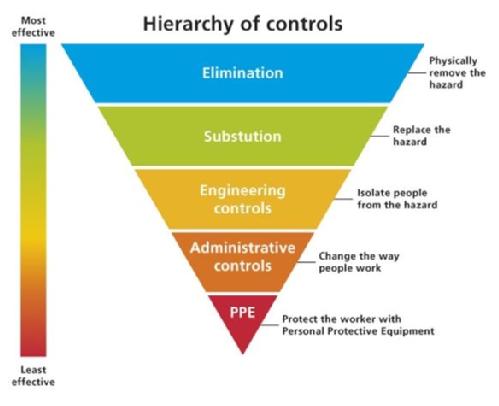Risk Controls
Reasonably practicable
Risks must be assessed and must be controlled to ensure the level of risk is 'as low as is reasonably practicable'. This means balancing the level of risk against the time, effort and cost associated with the introduction, and ongoing maintenance, of any risk controls. As soon as a risk has been deemed to be at a tolerable level, you do not need to take any further action if the cost and complexity of any further control measures would be grossly disproportionate to the reduction in the level of risk achieved.
The hierarchy
Health and Safety law requires that control measures be considered in a strict priority order, using what is referred to as a risk control hierarchy. The hierarchy to be considered is:
 |
1. Eliminate the hazard – stop the activity altogether or redesign the j |
|
2. Substitution - replace the material or process with a less hazardous one |
|
|
3. Engineering controls - separate people from hazards by enclosing chemicals or guarding dangerous items of machinery/equipment. Priority must be to measures which protect collectively. Local Exhaust Ventilation (LEV) would be a good example of an Engineering control. |
|
|
4. Administrative controls - implementing any procedures required to help those you need to work safely |
|
|
5. Personal Protective Equipment – this should only be considered after all other control measures above have been considered and found not to be reasonably practicable. |
Other considerations
Controlling risk ‘at source’ is a more reliable option than personal protective equipment (PPE) which relies on the individual remembering to wear it, and wearing it properly. Where adequate control cannot be provided by a single control measure it might be necessary to provide some controls in combination with other control measures, thus providing 'defence in depth'.
When considering control measures it is also worth keeping in mind the time, effort and cost associated with the ongoing management or supervision associated with certain controls. Control measures such as substitution and engineering controls tend to be more effective than procedures or a reliance on PPE, and take up far less management or supervisory time once implemented.
Controls which provide collective protection (e.g. edge protection on a roof) are preferable to those which only provide individual protection (e.g. fall arrest harnesses).
Residual Risk and Risk Assessment Approval
All residual risks outlined in a risk assessment must be accepted as being 'tolerable' to the Department by a competent person(s) which may be a person's supervisor or line manager, a research group lead, a principal investigator, Facility or Laboratory Manager or an established competent peer or governing group or Committee. Essentially, the person(s) who approve and sign off the risk assessment, must have sufficient knowledge and experience of the subject matter/activity, the work environment where the activity is being proposed and to a degree, the individual concerned, to be able to make a reasonable judgement as to whether the risk assessment is 'suitable and sufficient' or whether to challenge the author(s) to consider any additional hazards that they consider could arise in connection with the work proposed. Until the risk assessment is signed off by such a person(s), the area or work activity that the risk assessment covers is not authorised and therefore should not be carried out.
Whilst the responsiblity for risk management is best placed with the person(s) who create the risks with risk control being a line management responsibility, there could be situations that arise, through the process of risk assessment where, even after the implementation of all control measures (as stated above), a number of residual risks remain, which are either 'Moderate' or 'High'. An example could be, working with stored energy (batteries) where normal electrical isolation is not possible and persons are working with high voltages. Under such circumstances, and particularly where the residual risk after risk controls have been put into place remains 'High', a higher level of risk assessment approval must be considered by the Department concerned. Any residual risk remaining 'High' must be deemed 'tolerable' to the Head of Department which may be governed through local Health and Safety Committee or directly through the Head of Department depending on departmental governing structures. The governing arrangements for biological work is considered under Biological SafetyLink opens in a new window.
Further Advice
If you require access or any further information discuss with your Departmental Contact or get in touch with the Health & Safety team by using the Assure system and filling in an 'Ask for Advice' formLink opens in a new windowLink opens in a new window.
